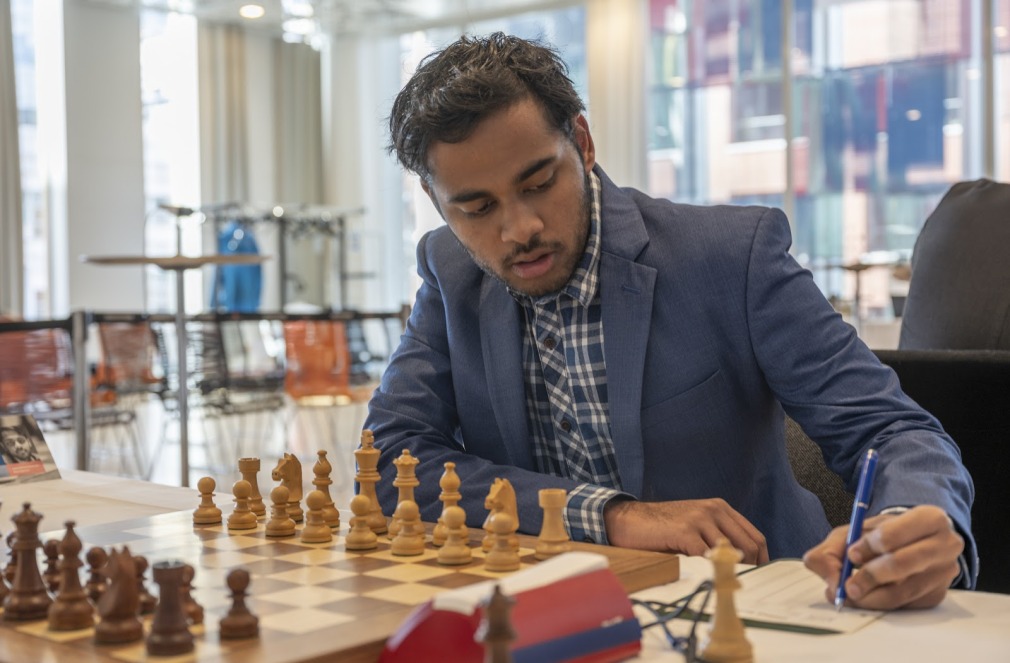A star on the rise
Indian grandmaster Arjun Erigaisi is one of the rising stars of recent times. As a 13-year-old, he won the gold medal in the Asian U14 Championships in 2017. At 14 years, 11 months and 13 days, he became one of the youngest players in chess history to be awarded the grandmaster title. And in 2019, he won the U16 Commonwealth Championships.
Despite his successes, Arjun was somewhat overshadowed by other Indian talents like Praggnanandhaa, Nihal Sarin and Gukesh, who made more headlines for a while. But with his impressive performance at the Goldmoney Asian Rapid tournament last year, Arjun played his way into the limelight. Finally, with his remarkable victory at the Challenger tournament in Wijk aan Zee, it was clear that a major star was on the rise.

India, with its many strong players, occupies fourth place in the FIDE ranking of countries. And Arjun, with a 2675 rating, is also number four in India’s national ranking. Only Anand, Vidit and Harikrishna are ahead of him. In the list of top 100 juniors, Arjun has moved past Vincent Keymer to number three, behind Alireza Firouzja and Andrey Esipenko.
In the first round of the Tepe Sigeman & Co tournament in Malmö, the youngster emerged victorious from a sharp tactical battle against Alexey Shirov in the Botvinnik Variation of the Semi-Slav Defence.
In the second round, again playing white, he faced Saleh Salem from the United Arab Emirates. With an Elo of 2690, Salem was the slight rating favourite. However, the game soon became one-sided. Salem came out of the opening quite well in the Fantasy Variation of the Caro-Kann Defence, but then failed to find a good plan, while his opponent systematically built up an attacking position.
 The Fantasy Variation (1.e4 c6 2.d4 d5 3.f3) is a tricky try by White to steer the game into muddy waters right from the off and take Black away from the solid positions he is accustomed to in the main line variations of the Caro-Kann. Traditionally the opening never gained too much credibility amongst top players, since White's attempt to preserve his pawn centre at the cost of weakening his kingside was hardly seen as a major threat to the super-reliable Caro. However, thanks to a wave of news ideas and innovations first introduced at the 2010 European Individual Championships and many more thereafter, the variation has made a major comeback and can now be found in the repertoires of some of the world's best. In this 60 minute video, IM Lawrence Trent will discuss the 5 main variations Black has at his disposal but how with each one White has a number of ways to keep the position full of play and dynamic possibilities, leading to games which loyal Caro players will have difficulty dealing with.
The Fantasy Variation (1.e4 c6 2.d4 d5 3.f3) is a tricky try by White to steer the game into muddy waters right from the off and take Black away from the solid positions he is accustomed to in the main line variations of the Caro-Kann. Traditionally the opening never gained too much credibility amongst top players, since White's attempt to preserve his pawn centre at the cost of weakening his kingside was hardly seen as a major threat to the super-reliable Caro. However, thanks to a wave of news ideas and innovations first introduced at the 2010 European Individual Championships and many more thereafter, the variation has made a major comeback and can now be found in the repertoires of some of the world's best. In this 60 minute video, IM Lawrence Trent will discuss the 5 main variations Black has at his disposal but how with each one White has a number of ways to keep the position full of play and dynamic possibilities, leading to games which loyal Caro players will have difficulty dealing with.

The other three games ended drawn. Alexey Shirov and Jorden van Foreest had a wild battle in the Advance Variation of the Caro-Kann, in which the Spaniard never castled. The game between Michael Adams and Nils Grandelius in the Najdof Variation with 6.Be2 was calmer. David Navara and Hans Niemann also split the point after an interesting game in which White gave up his queen for a rook and a minor piece.
Round 2 results
Standings after round 2
All games
Links

























